Click here to get this article in PDF
Source: The Critical Investor for Streetwise Reports 02/22/2021
The Critical Investor examines the latest news from Treasury Metals, including an integrated PEA for the combined Goliath-Goldlund project and an upsized financing.
After acquiring the neighboring Goldlund open pit project from First Mining Gold Corp. (FF:TSX), Treasury Metals Inc. (TML:TSX: TSRMF:OTCQB) has been busy ever since, to integrate both projects into a single open pit-underground project with synergies whenever possible. After hiring Ausenco, a reputable engineering firm, and appointing a new president and CEO, Jeremy Wyeth, who has lots of experience in building mines, the company worked diligently for six months on an integrated preliminary economic assessment (PEA) for both projects.
From his bio, Wyeth seems the right man in the right place, considering his background. The highlight of his career is undoubtedly the development, construction, commissioning and ramp-up of the Victor Diamond Mine in northern Ontario, owned by De Beers. He took the Victor project from preliminary feasibility study (PFS) to nameplate capacity. The Victor Project had a capital budget of $1 billion, and under Mr. Wyeth’s leadership, it was completed nine months ahead of schedule and under budget. Before this, he worked on mines around the world in Canada, Russia, Brazil and South Africa, and after the completion of the Victor diamond mine he was operations director at a large engineering firm.
Before I delve into the PEA results, I would also like to briefly mention the recently completed phase 1 infill and expansion drill program at Goldlund, which accounted for a 10,000-meter (10,000m) diamond drill program. The goal of management was to convert Goldlund Inferred resources into Indicated resources, improve continuity and establish a small maiden resource for the Miller target, all this to be used in the aforementioned combined PEA.

The drilling focused on filling in under-drilled Zones 2 and 3 of Goldlund. Initial reported results of this program were decent, including hole GL-20-037, which includes 2.23 g/t gold over 10.0m from 82m depth, including 2.99 g/t gold over 6.0m, and GL-20-035, which includes 1.41 g/t gold over 17.6m from 167m depth at Goldlund.

The news release mentioned the holes, which weren’t included in the PEA, but most of the pending results for Zones 1, 4, 7 and 8 at the time of the release were included, although these weren’t disclosed yet, so my guess is they will be available for the general public when the PEA is filed. Another set of 12 results was announced for Zones 2, 3 and 6 on Feb. 11, 2020. Standout holes were GL-20-043, returning 15m at 7.15g/t Au, including 1m at 83.7g/t Au from 74m depth; GL-20-046, returning 37.7m at 1.18 g/t Au from 1.3m depth; GL-20-49, returning 9.5m at 5.15 g/t Au, including 1m at 19.90 g/t Au and 0.6m at 33.90 g/t Au from 56m.
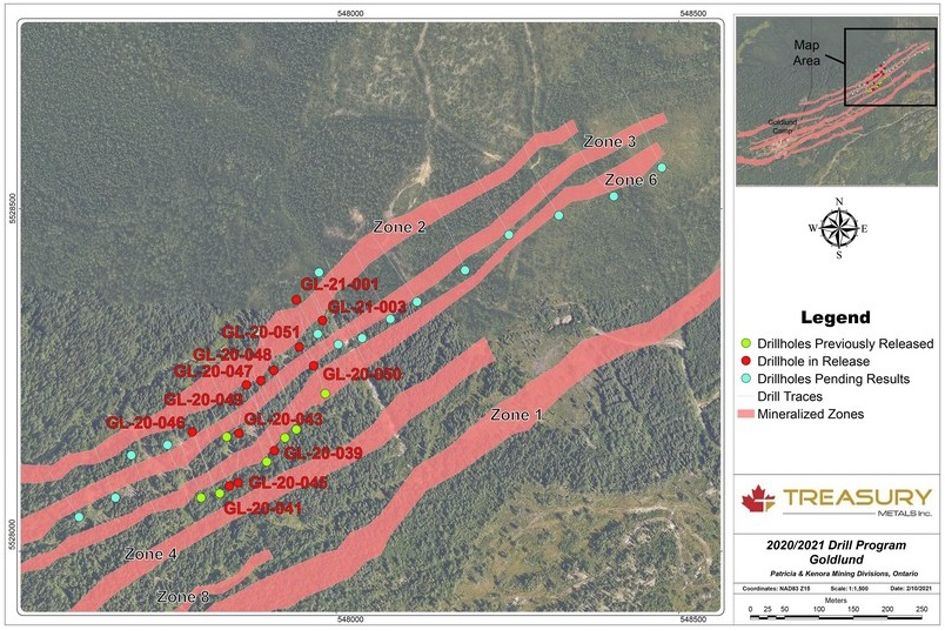
These results were excellent, as they were all well within open pit depth, and targeted the northeast section of the combined PEA open pit at Goldlund, in order to delineate additional resources as well as convert Inferred resources into Indicated resources. Management has identified over 40,000m of drilling at Goldlund, for infill and expansion purposes.
As a consequence, a follow-up program will start in March, and management is designing a resource expansion program for its nearby Goliath project as well. As the deposits/targets are all in different stages of development, Treasury Metals aims at a four-stage development of their deposits, comparable to the hub and spoke strategy of Atlantic Gold Corp. and its MRC project, which has been taken over in 2019 by St. Barbara Ltd. (SBM:ASX) for CA$802 million (CA$802M).

Please note that this table might show a bit of an underrated view of the Atlantic Gold story compared to the one of Treasury Metals, as the total production from MRC is planned to be 1.46 million ounces (1.46 Moz) Au, with peak production of 254,000 ounces Au. Treasury’s combined project, despite the larger resources and higher gold price, has a smaller production profile and is much less profitable. For a quick idea of MRC, here is an overview of the expansion PFS, based on the original feasibility study:
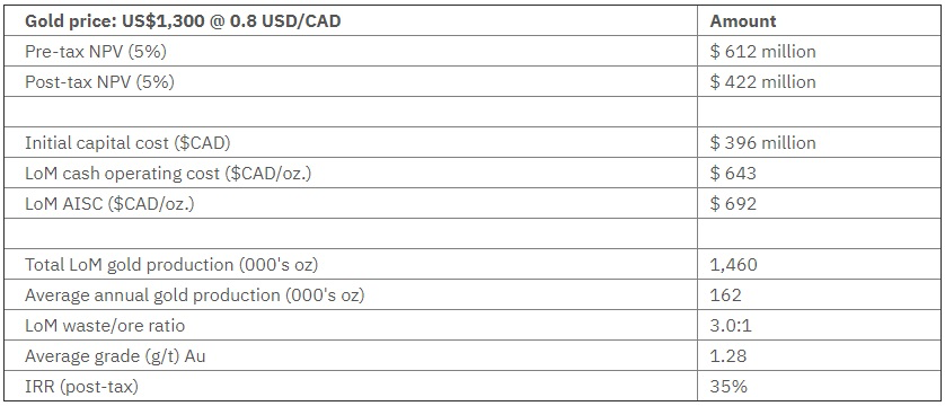
These are pretty good numbers, and although I published some critical work on Atlantic done by fellow analyst Dekker regarding the achievability of these numbers, fact is that Atlantic has been taken out during ramp-up for a hefty price tag. On the other hand, the AISC reported by current owner, St. Barbara, keeps hovering around CA$950/oz, which is significantly above Atlantic’s PFS/FS calculations (CA$692/oz), so looking in hindsight, Kees might have been on to something substantial after all.
Notwithstanding this, at the current gold prices, St. Barbara is doing just fine with these results. But proving up economic studies by commercial production has been a problematic subject lately, with several projects having failed completely the last years (Baja, RB Energy, Midway, Red Eagle, Rubicon, Nemaska), or others having substantial ramp-up issues lasting over one or more years (Detour, Orocobre, Pretium). As the new Treasury Metals CEO, Wyeth, with all his impressive operational expertise, probably is aware of these cases and many more. Let’s have a look what the impact is of his stance toward the recently published combined PEA, but also the 2017 PEA.
When Treasury Metals published the results of the combined PEA on Feb. 2, 2021, I was immediately puzzled by the NPV (net present value) and the used price of gold. The NPV figures weren’t notably higher compared to the 2017 Goliath PEA (CA$328M now versus CA$306M in 2017), which used a much lower base case gold price of US$1,225/oz Au versus the combined base case gold price of US$1600/oz Au. This is remarkable, as the resource base of both projects is two times larger than Goliath alone, and a much higher base case gold price usually results in a much higher NPV. This begs for some scrutiny, as you will understand. When I put the basic metrics of both PEAs together in one table, normalized for a US$1,225/oz gold price, we get the following comparison, with the most important changes marked in green:
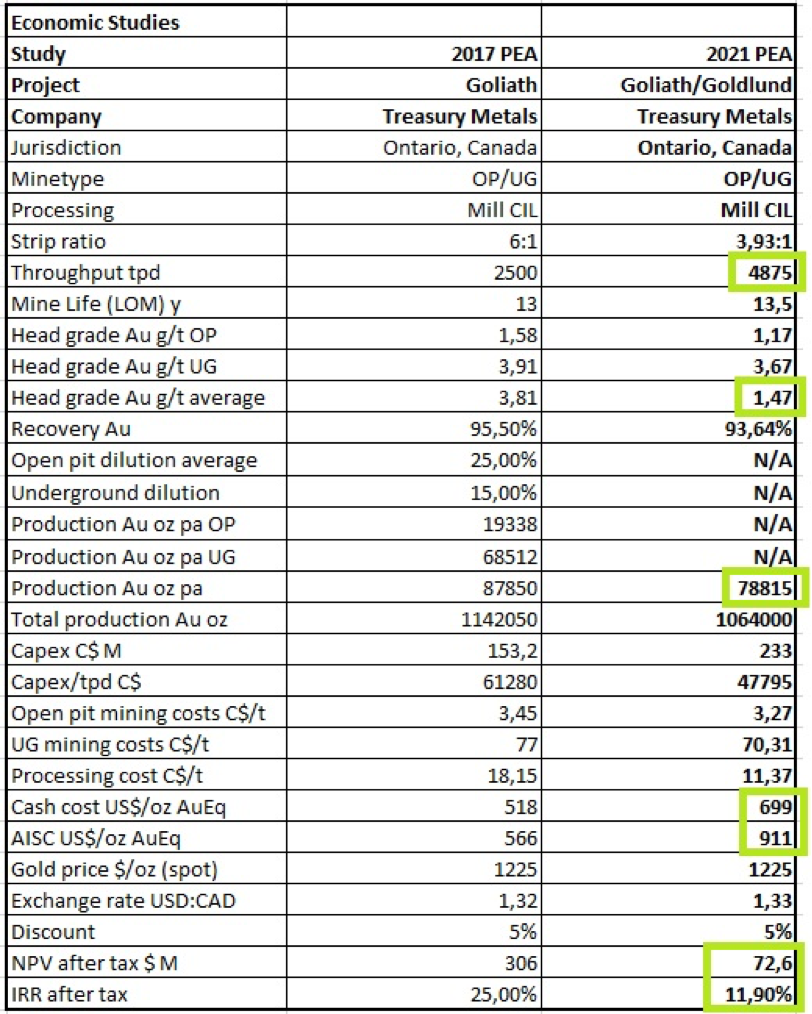
As can be seen, the size of the mining operation has doubled, whereas the average head grade has dropped from 3.81 g/t to 1.47 g/t Au. This was caused by integrating part of the Goldlund open pit resources, which had lower grades, into the project. What really surprised me was the drop in average annual production, as I definitely expected the combined project to produce over the magic threshold of 100,000 oz Au annually. As a result, with almost the same life of mine (LOM), total gold production didn’t grow but actually decreased from 1.14 Moz to 1.06 Moz Au. Keep in mind the Goliath resource base stood at 1.4Moz Au, and the combined Goliath/Goldlund resource at 3.1 Moz Au, but management adapted a more conservative approach. This was the old resource estimate for Goliath:
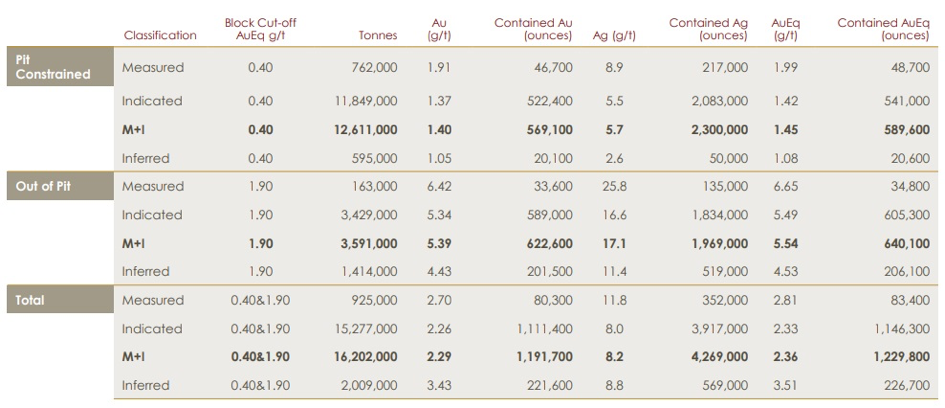
And the old Goldlund estimate, compared with the former 2017 estimate:

This is the current resource estimate for both Goliath and Goldlund (a satellite deposit of Goldlund called Miller is included, but very small):
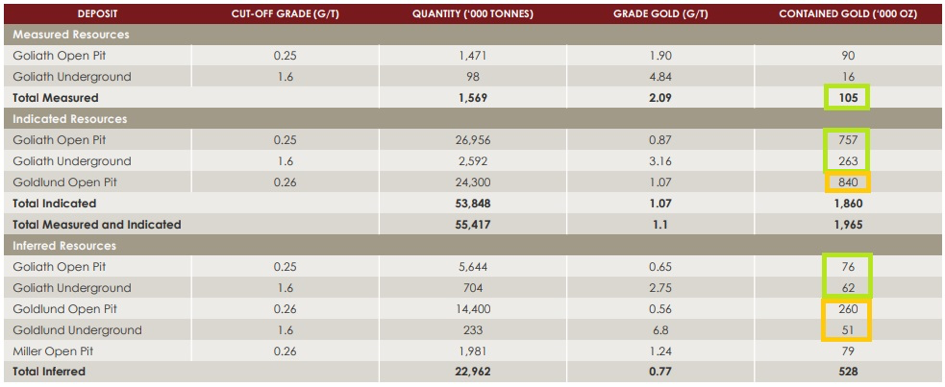
The Goliath open pit component was adjusted from 569,000 oz at 1.40 g/t Au M&I to 847,000 oz at 0.99 g/t Au, as management used a much lower cut-off but also a different methodology:
“For Goliath, this differs from the previous mineral resource estimate approach that used discrete wireframes created from both geological contacts and drill assay results for the underground model and wider wireframes for the open pit model. With the new methodology, the entire mineralized corridor for the Main Zone and C-Zone were wireframed conventionally and then, internally sub-divided in a low grade, medium grade and high-grade components using a probabilistic approach. The resulting single model respects the known geological information while ensuring that the grade distribution is more representative of the field condition. This has resulted in having a more conservative approach to continuity of the mineralization in both the low grade (Open Pit) and high grade (Underground) zones.”
For the underground component of Goliath, this meant a change from 623,000 oz Au at 5.39 g/t Au M&I to 368,000 oz Au at 3.25 g/t Au M&I, also at a lower cutoff (1.9 g/t versus 1.6 g/t). This is remarkable, as a lower cutoff usually includes more ounces.
It also effectively means that the underground component is almost rendered uneconomic at more conservative gold prices (US$1,200–1,300/oz), so this is quite an adjustment. Management was forthcoming in why they felt the need to adjust it like this, and VP Projects Wheeler stated: “As the project moves to a construction decision, we have to be absolutely certain that we are confident in the material we are able to mine to make a critical mass. This conservative approach with a very high portion of M+I ounces allows us to present a realistic PEA that we have significant opportunities to add upon and mitigating risks of downgrade as we move towards greater detail in future studies.”
For Goldlund, the changes were also substantial using lower cutoffs (these were 0.40 g/t Au, now 0.26 g/t Au OP and 1.6 g/t Au underground), as the M&I component went from 809,000 oz at 1.96 g/t Au to 840,000 oz at 1.07 g/t Au, so at almost half the grade. Such a decrease in grade affects the profitability a great deal, so management definitely wasn’t happy. The Inferred component was adjusted from 877,000 oz at 1.49 g/t Au to 260,000 oz at 0.56 g/t Au open pit, and 51,000 oz @ 6.8 g/t underground, almost neutralizing the original Inferred open pit part, and introducing a very small underground high-grade component. This isn’t the first robust correction Goldlund has seen in its history, as it was already downsized from the 3.3 Moz resource at the time of the acquisition in 2016, to 2.3 Moz in 2017, to 1.6 Moz in 2019, to 1.2 Moz now, so it keeps getting smaller.
It made me wonder a couple of things. First of all, it made me curious if this conservative stance was coming from CEO Wyeth, as he is the only new factor in the story, and what triggered him to overhaul the resource estimates. Was this his usual MO, or did he notice certain things? He had this to say: “My belief is that we want to use this as a base to build from. The last thing we want is to be coming to the market in nine months with apologies and reasoning as to why we haven’t hit our targets. Past successes have taught me that we want to under promise and over deliver.”
The new resources also made me contemplate if Treasury currently thinks they did enough due diligence on the asset when it was bought from First Mining, if they still think the price was right, and what their expectations are for resources. Management had this to say: “The purchase of the Goldlund process has always been about the potential for the two properties to gain a critical mass and grow using the significant strike length for exploration. We remain confident in the Goldlund asset as can be shown in the M+I resources that remain contained within the resource estimate. Much of the drop has come from the indicated category and we see opportunities to both gain back those resources through the drilling we are currently doing, further revisions to the geological knowledge and modelling of high grade zones and very importantly the development of the trend as a whole. We currently have more the 62km of strike length that needs to be explored for growth like has happened with the newly developed Miller deposit.”
The second intriguing aspect of this combined PEA was the huge increase in all-in sustaining costs (AISC). To see these costs rise with 61% is unheard of, for me in 10 years of doing junior mining research at least, for economic studies that are both NI-43-101-compliant. I have seen JORC-compliant (Australia) economic studies being adjusted, or rather corrected, dramatically when projects owned by Australia-listed companies were taken over by Canada-listed companies; I have seen JORC estimates adjusted by 50% to NI-43-101 resource estimates; also strongly revised NI-43-101 resource estimates, but this is a first. A comparison of both PEAs for cash costs/AISC looks like this:
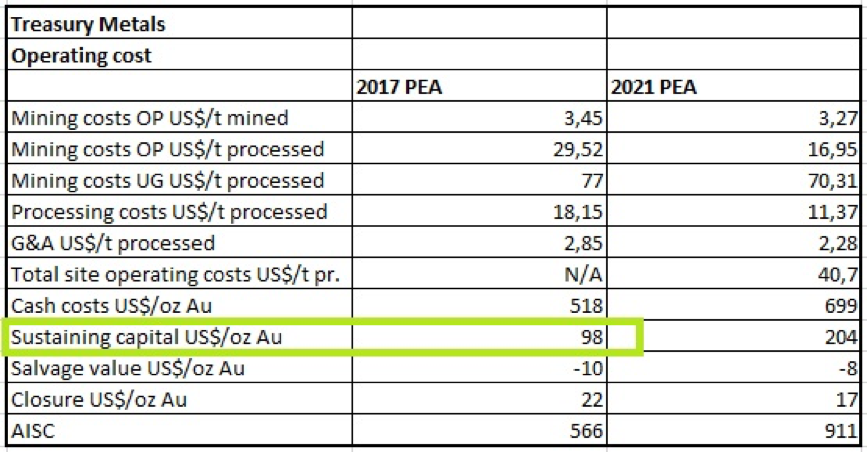
As we can see, the costs per tonne don’t differ too much, but the issue here is the average grade is much lower, so the costs per ounce increase. As more production comes from a relatively cheaper open pit operation at Goldlund, cash costs remain at acceptable levels. Things go wrong at the AISC side of things, with sustaining capital exploding.
In the 2017 PEA, sustaining capital was extremely low, at a total of just CA$12M, but underground development and equipment (CA$96M) was, for some reason, quoted separately. When I calculated sustaining capital per ounce in order to reconstruct AISC, I noticed things didn’t add up, as cash cost plus sustaining capital would generate an AISC way over US$620/oz instead of US$566/oz. It almost seemed like underground development, which usually is labeled as sustaining capital, was left out. Management had no comment on this subject.
Sustaining capital was not separately addressed and specified in the 2017 PEA unfortunately. In the 2021 PEA, sustaining capital was more adequately calculated in my view:
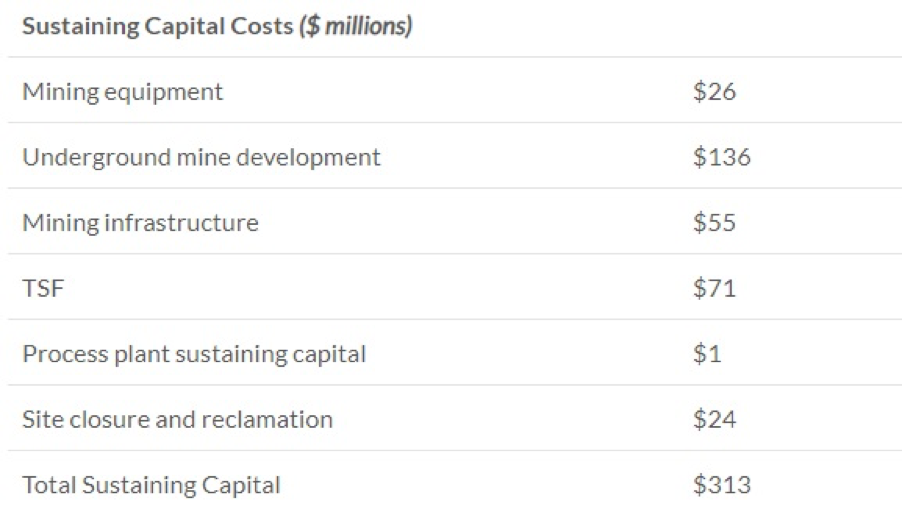
Of note are the increase in underground mine development and mining equipment, but especially the significant items Mining Infrastructure and Tailings Storage Facility (TSF). I wondered if these items were taken from the initial capex, in order to increase the IRR (internal rate of return), as most of the infrastructure and a TSF usually is constructed before production, as you simply need both from the start. According to VP Projects Mark Wheeler: “We have used leased equipment to attempt to minimize the needed upfront capital and as such this does have a positive effect on the IRR of the project. We have taken a much more conservative view on the cost of tailings construction and have planned as such for a phases approach. Additional detailed optimization work will be completed in the PFS to ensure capital is spent in the most efficient manner possible.”
Another item that caught my attention was the mining schedule. As management told me last year, they are aiming at getting Goldlund into production about three years after Goliath, which made sense due to permitting and funding construction at Goldlund by internal cash flow. I noticed something different in the schedule:

In this schedule, Goldlund is planned to go into production in year one, together with Goliath. As I don’t expect Goliath to be shelved during the full permitting procedure of Goldlund, management had the following explanation for this: “We have assumed that Goldlund is approximately 1-year delayed on permitting of Goliath. As such, with an 18-month Goliath construction period, and a resource that comes to surface at Goldlund with minimal pre-stripping needed, we are afforded the opportunity to start Goldlund with minimal delay to the production start of mining.”
It seems that incoming CEO Wyeth definitely had some cleaning up to do regarding resources of both Goliath and Goldlund, and the 2017 PEA on Goliath. If both the resources and grades would have hold up better, there is no doubt in my mind that the combined NPV of both projects would have superseded values of CA$700M at US$1,600/oz Au, instead of the current CA$328M. Investors in Treasury Metals weren’t too happy as the stock sold off when the PEA results were announced:
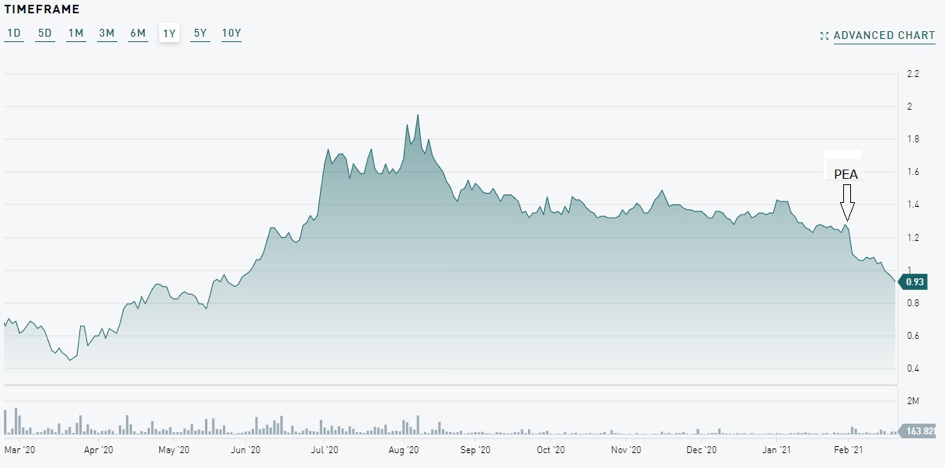
Share price; 1-year time frame (Source tmxmoney.com).
As gold went down further the last few weeks, so did gold equities, providing additional pressure for the Treasury share price. Notwithstanding this, I believe it is better for everybody to paint a clear picture as early as possible, and I am sure Wyeth, as a high-level executive with lots of high-quality experience, will do whatever he can to restore future potential for investors. He had this to say when asked: “We are very happy with the overall result. The mining plan and economic results are reasonable and achievable and with the drilling plan in place and drills turning on site we see significant opportunity to add to the resources and in turn significantly de-risk the project with that growth.”
At this point, the company has sufficient funds, and currently has about CA$11M in the treasury. Notwithstanding this, on Feb. 17, 2021, the company announced a CA$15M financing, consisting of a CA$10M non-flow through bought deal based on CA$0.95 NFT special warrants, and a CA$5M flow through private placement at a combination of CA$1.10 and CA$1.33 (Charity) FT special warrants. The NFT warrants will be exercisable into common shares, and the FT warrants into flow-through common shares. The holding period is a standard four months and one day. The financing is led by Haywood, Cormark Securities and Sprott Capital Partners, and the underwriters have the option to buy another CA$1.5M NFT special warrants. Per the news release:
“The net proceeds of the NFT Special Warrants will be used to fund exploration and trade-off optimization studies as part of the pre-feasibility study work and development of the company’s Goliath Gold Complex projects, as well as for general working capital purposes. The gross proceeds from the sale of the FT Special Warrants and Charity FT Special Warrants will be used by the company to incur eligible ‘Canadian exploration expenses’ that qualify as “flow-through mining expenditures” (within the meaning of the Income Tax Act (Canada)), related to the Company’s Goliath Gold Complex projects in Ontario.”
The financing was just upsized from CA$15M to CA$17.5M, and is expected to close in early March. The underwriters also have an over-allotment options which could see the financing upsized further. After closing the company is expected to have at least about CA$28M in cash. This is enough to get them through PFS exploration and optimization, and completion of the PFS itself, which is expected at Q2, 2022.
As a reminder, Treasury holds a convertible debt of CA$4.5M, carrying an 8% interest. The debenture is held by two of the largest equity holders in the company, Extract Capital and DSC, which are supportive.
After this quick financial update, let’s have a look at valuations. As I always like to see where the analyzed company stands among its competitors, I updated the peer comparison:
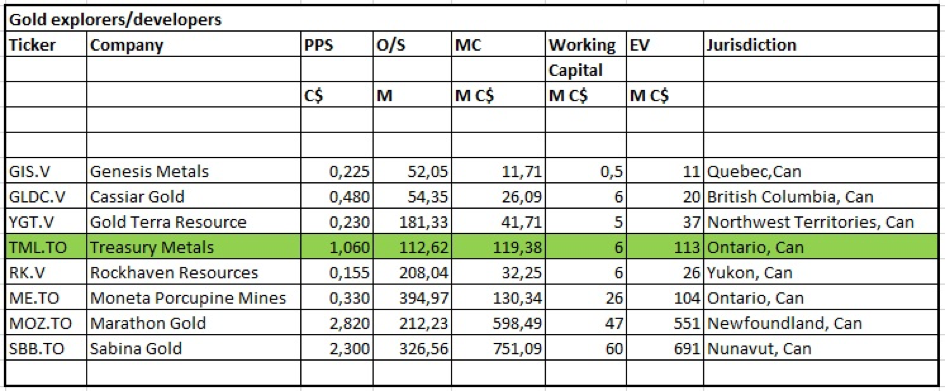
And:

And finally:
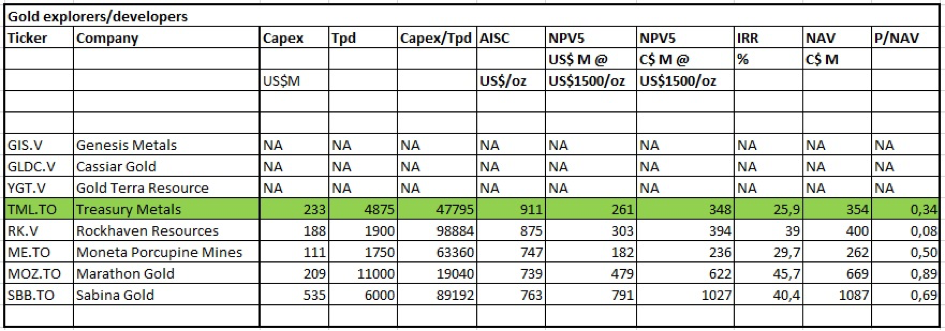
As can be seen, Treasury Metals still has lots of upside potential, as profitable projects at PFS/FS/construction level usually approach EV/oz values of US$80¬100 or even higher, and P/NAV values going to 1 when going into production. Realistically, a gold price of US$1,500/oz is very conservative in a US$1,800/oz environment, so evidently when calculated NAV on the then-current gold price will be much higher, P/NAV will have more room to run as well when commercial production is about to start.
For now, and with gold remaining above an assumed US$1,600/oz for the next few years, a double from today’s share price isn’t unrealistic at all for Treasury Metals, when going into production, including the inevitable dilution that comes with capex funding. This is based on no resource growth, a gold price of US$1600/oz, and no improved economics, so pretty conservative. This will take time of course, and I’m looking forward to the next steps in the new course of CEO Wyeth, who seems extremely professional about his business.
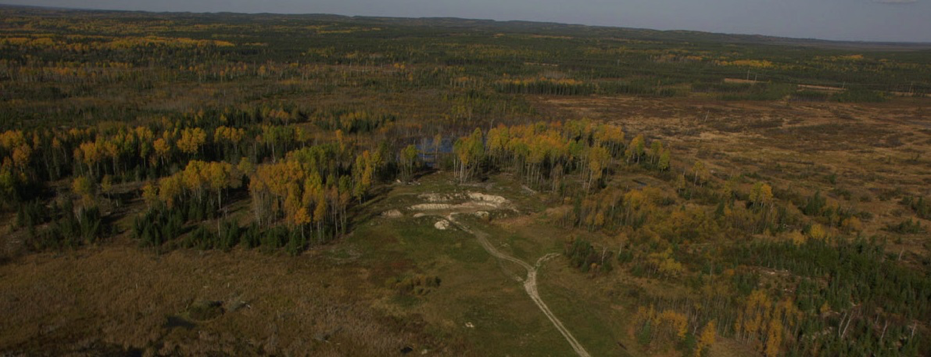
Conclusion
The combined PEA of Goliath and Goldlund surprised a lot of investors, and unfortunately not in a positive way. As the new CEO Jeremy Wyeth has intimate knowledge of everything that can go wrong with mining projects from resource to production, he set out to heavily scrutinize everything that Treasury brought to his table. Both the resources of Goliath and Goldlund decreased as a consequence, and the 2017 PEA on Goliath could basically be thrown into the shredder. Although the current potential is significantly lower, there is still upside, and now it is conservative and realistic.
As Wyeth is a mine builder who has proven he can work in time and under budget at projects much larger than at his current job, there is no doubt in my mind he will waste no time advancing the Goliath Gold Complex in the best possible way. He already rounded up the support of influential parties like Sprott Capital Partners, who don’t take due diligence lightly, and will probably soon have at least an additional CA$17.5M at his disposal. Let’s see where he can take Treasury Metals in this gold bull market.
All presented tables are my own material, unless stated otherwise. All pictures are company material, unless stated otherwise. All currencies are in US dollars, unless stated otherwise.
I hope you will find this article interesting and useful, and will have further interest in my upcoming articles on mining. To never miss a thing, please subscribe to my free newsletter on my website www.criticalinvestor.eu, in order to get an email notice of my new articles soon after they are published.
The Critical Investor is a newsletter and comprehensive junior mining platform, providing analysis, blog and newsfeed and all sorts of information about junior mining. The editor is an avid and critical junior mining stock investor from The Netherlands, with an MSc background in construction/project management. Number cruncher at project economics, looking for high quality companies, mostly growth/turnaround/catalyst-driven to avoid too much dependence/influence of long-term commodity pricing/market sentiments, and often looking for long-term deep value. Getting burned in the past himself at junior mining investments by following overly positive sources that more often than not avoided to mention (hidden) risks or critical flaws, The Critical Investor learned his lesson well, and goes a few steps further ever since, providing a fresh, more in-depth, and critical vision on things, hence the name.
Sign up for our FREE newsletter at: www.streetwisereports.com/get-news
Disclaimer: The author is not a registered investment advisor. Treasury Metals is a sponsoring company. All facts are to be checked by the reader. For more information go to www.treasurymetals.com and read the company’s profile and official documents on www.sedar.com, also for important risk disclosures. This article is provided for information purposes only, and is not intended to be investment advice of any kind, and all readers are encouraged to do their own due diligence, and talk to their own licensed investment advisors prior to making any investment decisions.
Streetwise Reports Disclosure:
1) The Critical Investor’s disclosures are listed above.
2) The following companies mentioned in the article are sponsors of Streetwise Reports: None. Click here for important disclosures about sponsor fees. The information provided above is for informational purposes only and is not a recommendation to buy or sell any security.
3) Statements and opinions expressed are the opinions of the author and not of Streetwise Reports or its officers. The author is wholly responsible for the validity of the statements. The author was not paid by Streetwise Reports for this article. Streetwise Reports was not paid by the author to publish or syndicate this article. Streetwise Reports requires contributing authors to disclose any shareholdings in, or economic relationships with, companies that they write about. Streetwise Reports relies upon the authors to accurately provide this information and Streetwise Reports has no means of verifying its accuracy.
4) The article does not constitute investment advice. Each reader is encouraged to consult with his or her individual financial professional and any action a reader takes as a result of information presented here is his or her own responsibility. By opening this page, each reader accepts and agrees to Streetwise Reports’ terms of use and full legal disclaimer. This article is not a solicitation for investment. Streetwise Reports does not render general or specific investment advice and the information on Streetwise Reports should not be considered a recommendation to buy or sell any security. Streetwise Reports does not endorse or recommend the business, products, services or securities of any company mentioned on Streetwise Reports.
5) From time to time, Streetwise Reports LLC and its directors, officers, employees or members of their families, as well as persons interviewed for articles and interviews on the site, may have a long or short position in securities mentioned. Directors, officers, employees or members of their immediate families are prohibited from making purchases and/or sales of those securities in the open market or otherwise from the time of the decision to publish an article until three business days after the publication of the article. The foregoing prohibition does not apply to articles that in substance only restate previously published company releases.
Charts and graphics provided by the author.
( Companies Mentioned: TML:TSX: TSRMF:OTCQB,
)
